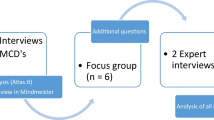Abstract
This paper examines one aspect of professional practice for bioethicists: managing conflicts of interest. Drawing from our qualitative study and descriptive analysis of the experiences of conflicts of interest and/or conflicting interests (COI) of 13 Canadian clinical bioethicists (Frolic and Chidwick 2010), this paper examines how bioethicists define their roles, the nature of COIs in their roles, how their COIs relate to conventional definitions of conflicts of interest, and how COIs can be most effectively managed.
Similar content being viewed by others
References
American Society for Bioethics and Humanities. (1998). Core competencies for health care ethics consultation: the report of the American Society for Bioethics and Humanities. Glenview, IL: American Society for Bioethics and Humanities.
Baker, R. (2005). A draft model aggregated code of ethics for bioethicists. American Journal of Bioethics, 5(5), 33–41.
Baker, R. (2009) In defense of bioethics. Journal of Law, Medicine & Ethics, Spring, 83–92.
Baylis, F. (Ed.). (1993). The health care ethics consultant. Totowa, NJ: Humana Press.
Boatright, J. (2001). Financial services. In M. Davis & A. Stark (Eds.), Conflict of interest in the professions (p. 219). New York: Oxford University Press.
Brody, B., Dubler, N., Caplan, A., Kahn, J., Kass, N., Lo, B., et al. (2002). Bioethics consultation in the private sector. Hastings Center Report, 32(3), 14–20.
Cain, D. M., Loewenstein, G., & Moore, D. A. (2005). Coming clean but playing dirtier: the shortcomings of disclosure as a solution to conflicts of interest. In D. A. Moore, et al. (Eds.), Conflicts of interest: challenges and solutions in business, law, medicine, and public policy (pp. 104–125). New York: Cambridge University Press.
Chambers, T. (2007). The virtue of attacking the bioethicist. In L. Eckenwiler & F. Cohn (Eds.), The ethics of bioethics: mapping the moral landscape (pp. 281–287). Baltimore: Johns Hopkins University Press.
Charland, L. (2008). By what authority? Conflicts of interest in professional ethics. Journal of Ethics in Mental Health, 3(2), 1–3.
Chidwick, P., Bell, J., Connolly, E., Coughlin, M., Frolic, A., Hardingham, L., et al. (2010). Exploring a model role description for ethicists. HEC Forum. doi:10.1007/s10730-010-9126-5.
Davis, M. (2001). Introduction. In M. Davis & A. Stark (Eds.), Conflict of interest in the professions (p. 8). New York: Oxford University Press.
Debruin, D. (2007). Ethics on the inside? In L. Eckenwiler & F. Cohn (Eds.), The ethics of bioethics: Mapping the moral landscape (pp. 161–169). Baltimore: Johns Hopkins University Press.
Donalson, T. (2001). The business ethics of bioethics consulting. Hastings Center Report, 31(2), 12–14.
Dubler, N. N., Webber, M. P., Swiderski, D. M., & the Faculty and the National Working Group for the Clinical Ethics Credentialing Project (2009). Charting the future: credentialing, privileging, quality, and evaluation in clinical ethics consultation. Hastings Center Report, 39(6), 23–33.
Freedman, B. (1989). Bringing codes to Newcastle: ethics for clinical ethicists. In B. Hoffmaster & B. Freedman (Eds.), Clinical ethics: theory and practice (pp. 125–139). Clifton, NJ: Humana Press.
Frolic, A., & Chadwick, P. (2010). A qualitative study of "conflicts of interests and/or conflicting interests" among Canadian bioethicists, Part 1: five cases, experiences and lessons learned. HEC Forum. 22(1). doi:10.1007/S10730-010-9124-7.
Harrison, C. (2000). Questions to ask about a job as a bioethicist. CBS Newsletter, 5(1), 9.
Kipnis, K. (1986). Conflict of interest and conflict of obligation. In M. Davis & F. A. Eliston (Eds.), Ethics and the legal profession (p. 291). New York: Prometheus Books.
Kipnis, K., Baker, R., Pearlman R., & Taylor, H. (2007). Report and recommendations on the ASBH Advisory Committee on Ethics Standards (ACES).
MacDonald, C. (2003). Draft model code of ethics for bioethics [on-line] www.bioethics.ca/publications-ang.html.
MacDonald, C., Coughlin, M., Harrison, C., Lynch, A., Murphy, P., Rowell, M., et al. (2000). Working conditions for bioethics in Canada (v. 8.0). CBS Newsletter, 6(2), 4–8.
MacDonald, C., McDonald, M., & Norman, W. (2002). Charitable conflicts of interest. Journal of Business Ethics, 39, 67–74.
Meyers, C. (2007). Clinical ethics consulting and conflict of interest: structurally intertwined. Hastings Center Report, 37(2), 32–40.
Norman, W., & MacDonald, C. (2009). Conflict of interest. In G. Brenkert & T. Beauchamp (Eds.), Oxford handbook of business ethics (pp. 441–470). New York: Oxford University Press.
Scofield, G. (2008). What is medical ethics consultation? Journal of Law, Medicine & Ethics, Spring, 95–118.
Sharpe, V. (2007). Strategic disclosure requirements and the ethics of bioethics. In L. Eckenwiler & F. Cohn (Eds.), The ethics of bioethics: Mapping the moral landscape (pp. 170–180). Baltimore: Johns Hopkins UP.
Stark, A. (2001). Comparing conflicts of interest across the professions. In M. Davis & A. Stark (Eds.), Conflicts of interest in the professions (pp. 335–352). New York: Oxford University Press.
Stark, A. (2005). Why are (some) conflicts of interest in medicine so uniquely vexing? In D. A. Moore, et al. (Eds.), Conflicts of interest: Challenges and solutions in business, law, medicine and public policy (pp. 152–180). New York: Cambridge University Press.
Tyler, T. R. (2005). Managing conflicts of interest within organizations: Does activating social values change the impact of self-interest on behavior? In D. A. Moore, et al. (Eds.), Conflicts of interest: Challenges and solutions in business, law, medicine, and public policy (pp. 13–35). New York: Cambridge University Press.
Weijer, C. (1999). We’re alright Jack. An argument urging CBS to develop a policy on working conditions for bioethicists. CBS Newsletter, 4(2), 11–12.
Author information
Authors and Affiliations
Corresponding author
Rights and permissions
About this article
Cite this article
Frolic, A., Chidwick, P. A Pilot Qualitative Study of “Conflicts of Interests and/or Conflicting Interests” Among Canadian Bioethicists. Part 2: Defining and Managing Conflicts. HEC Forum 22, 19–29 (2010). https://doi.org/10.1007/s10730-010-9125-6
Published:
Issue Date:
DOI: https://doi.org/10.1007/s10730-010-9125-6




